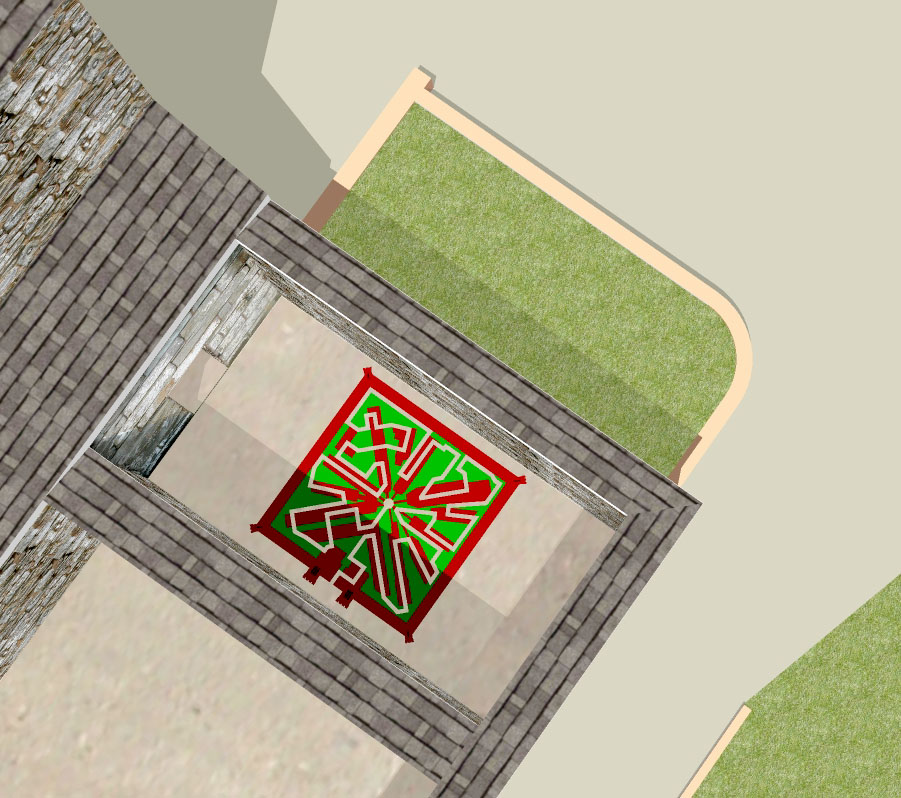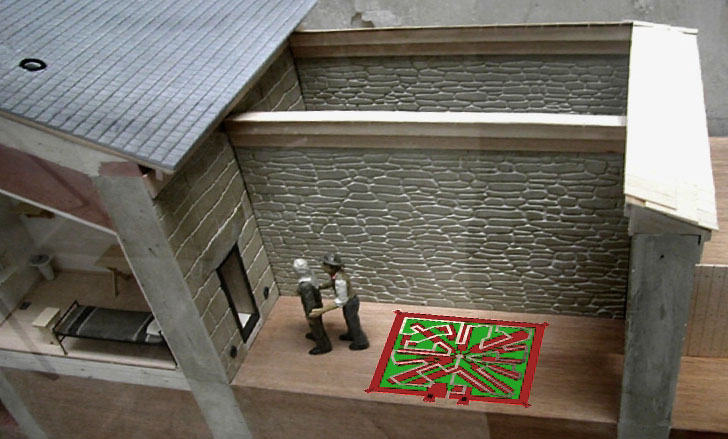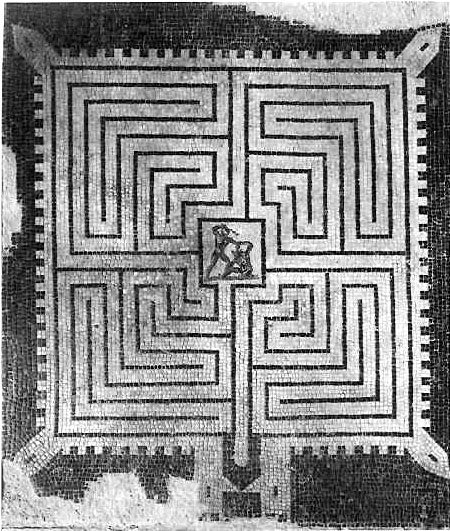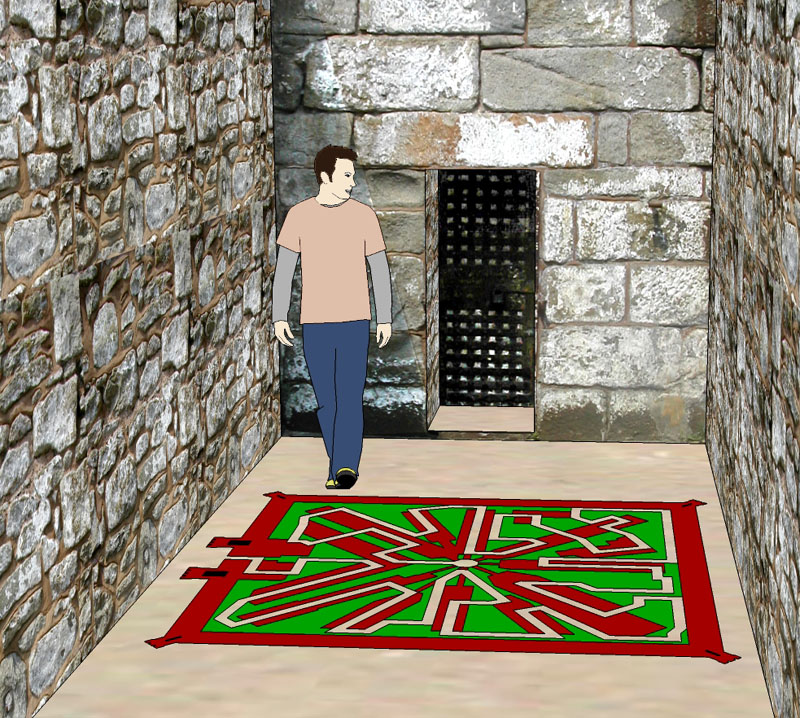
This is a proposal for a painted labyrinth image for the Art Installation program at Eastern State Penitentiary in the Fairmount section of Philadelphia. The labyrinth is located in the last remaining solitary exercise yard, and is an abstraction of the plan of the prison. The image is app. 7ft. x 7ft and will be painted on the concrete floor of the yard with interior latex house paint so as to naturally weather and eventually fade away.
The labyrinth as a symbol goes as far back as the petroglyphs of Neolithic and Bronze Age Europe (fig. 1). Many meanings have been assigned to the labyrinth by different cultures: initiation, the underworld, inprisonment, reincarnation, magic, enlightenment, and even cosmological and astral connotations. This proposal makes an analogy between some of the meanings given to the labyrinth and Eastern State Penitentiary, one that seems fitting for several reasons.
The labyrinth as walled city and prison:
The symbolism and actual design of labyrinths has historically been associated with the image of walled fortresses and prisons. The best known example of a labyrinth, the one at Crete which held the minotaur, was likened to a prison of no return (which it was not for Theseus, thanks to Ariadne.) Ancient Roman mosaic representations of labyrinths were usually depicted as fortified cities with walls, battlements, corner towers, and entrance gates (fig. 2), which is also an accurate description of Eastern State Penitentiary.
Additionally, the labyrinth as a place of disorientation and imprisonment has often been noted.1 In the case of Eastern State, the disorientation was planned: the prisoners were originally taken to their cells wearing hoods, and were also hooded when taken out of their cells. They thus would have had little idea of the layout of the prison and their relative position in it, and, had they been able to walk out of their own volition, would have had difficulty finding the correct way out except by a circuitous route. As well, the plan of the prison is very labyrinthine, especially with its later confusing additions. When I visited on the artists’ tour I actually ended up in the “Center” hub and was not sure which wing I should take to get me closest to the exit, and felt momentarily disoriented. This sense of disorientation must have been exponentially greater for the prisoners themselves.
The labyrinth as a transformative experience:
A more positive idea of transformation and transcendence is also associated with the labyrinth2 and this connects to the original philosophy behind Eastern State. One walks the labyrinth alone, and the following of the circuitious path concentrates one’s mind in a kind of meditation until the goal is reached. Upon reaching the goal, and coming back out, one is changed. As a noted labyrinth historian has stated:
“Therefore, turning around at the center does not just mean giving up one’s previous existence; it also marks a new beginning. A walker leaving a labyrinth is not the same person who entered it, but has been born again into a new phase or level of existence; the center is where death and rebirth occur.” 3
This meaning of the labyrinth can be a referent to the transformative effect that Eastern State Penitentiary was intended to have on those it held within its walls, as expressed by its many proponents.4 This “true regret” and eventual enlightenment was probably not reached in the case of most prisoners, so that the labyrinthine quality of the penitentiary more correctly rests in the “difficult” characteristics stated in the previous section.
The design
The Eastern State Penitentiary labyrinth is a representation of a unicursal (single-path) type, as opposed to a multi-path maze. The design is based on the prototype of the Roman mosaic labyrinth which was usually a depiction of a walled fortress or city. The plan is that of the Penitentiary as it exists today, simplified to a diagram. The design breaks from labyrinth tradition in that the path does not follow a fourfold symmetry in the four quadrants of the square. Instead, the path is guided by the logic of the floor plan and often follows the center hallways of the wings, but also breaks out in a meandering pattern. It leads from the entrance gate to the center hub.
The location
Placing the design in the one area where the prisoners were allowed to walk freely seems to me fitting, since a labyrinth, even in small designs, represents something meant to be walked through. As the exercise yard is too small for a design which can actually be walked, this labyrinth is more symbolic, just as the Roman ones were, and is an object of meditation and reflection on the idea of confinement and paths to freedom, and will be “walked” only by the mind. The labyrinth plan is placed within the exercise yard with its entrance facing south, to reflect Eastern State’s actual compass orientation.
A landscape labyrinth?
I also imagined the labyrinth as a landscape installation at a size which could be walked through. The ideal location would be the triangular lawn area labeled “Baseball Diamond” on the tour map. The plan elements would be made of boxwood grown to a couple of feet high, and the path would be made of gravel. However, the boxwood would need two years to grow, the labyrinth would then require continued maintenance, and the budget would likely be over the amount allotted by the proposal, so this scheme may have to remain an enticing dream.
The labyrinth as a symbol goes as far back as the petroglyphs of Neolithic and Bronze Age Europe (fig. 1). Many meanings have been assigned to the labyrinth by different cultures: initiation, the underworld, inprisonment, reincarnation, magic, enlightenment, and even cosmological and astral connotations. This proposal makes an analogy between some of the meanings given to the labyrinth and Eastern State Penitentiary, one that seems fitting for several reasons.
The labyrinth as walled city and prison:
The symbolism and actual design of labyrinths has historically been associated with the image of walled fortresses and prisons. The best known example of a labyrinth, the one at Crete which held the minotaur, was likened to a prison of no return (which it was not for Theseus, thanks to Ariadne.) Ancient Roman mosaic representations of labyrinths were usually depicted as fortified cities with walls, battlements, corner towers, and entrance gates (fig. 2), which is also an accurate description of Eastern State Penitentiary.
Additionally, the labyrinth as a place of disorientation and imprisonment has often been noted.1 In the case of Eastern State, the disorientation was planned: the prisoners were originally taken to their cells wearing hoods, and were also hooded when taken out of their cells. They thus would have had little idea of the layout of the prison and their relative position in it, and, had they been able to walk out of their own volition, would have had difficulty finding the correct way out except by a circuitous route. As well, the plan of the prison is very labyrinthine, especially with its later confusing additions. When I visited on the artists’ tour I actually ended up in the “Center” hub and was not sure which wing I should take to get me closest to the exit, and felt momentarily disoriented. This sense of disorientation must have been exponentially greater for the prisoners themselves.
The labyrinth as a transformative experience:
A more positive idea of transformation and transcendence is also associated with the labyrinth2 and this connects to the original philosophy behind Eastern State. One walks the labyrinth alone, and the following of the circuitious path concentrates one’s mind in a kind of meditation until the goal is reached. Upon reaching the goal, and coming back out, one is changed. As a noted labyrinth historian has stated:
“Therefore, turning around at the center does not just mean giving up one’s previous existence; it also marks a new beginning. A walker leaving a labyrinth is not the same person who entered it, but has been born again into a new phase or level of existence; the center is where death and rebirth occur.” 3
This meaning of the labyrinth can be a referent to the transformative effect that Eastern State Penitentiary was intended to have on those it held within its walls, as expressed by its many proponents.4 This “true regret” and eventual enlightenment was probably not reached in the case of most prisoners, so that the labyrinthine quality of the penitentiary more correctly rests in the “difficult” characteristics stated in the previous section.
The design
The Eastern State Penitentiary labyrinth is a representation of a unicursal (single-path) type, as opposed to a multi-path maze. The design is based on the prototype of the Roman mosaic labyrinth which was usually a depiction of a walled fortress or city. The plan is that of the Penitentiary as it exists today, simplified to a diagram. The design breaks from labyrinth tradition in that the path does not follow a fourfold symmetry in the four quadrants of the square. Instead, the path is guided by the logic of the floor plan and often follows the center hallways of the wings, but also breaks out in a meandering pattern. It leads from the entrance gate to the center hub.
The location
Placing the design in the one area where the prisoners were allowed to walk freely seems to me fitting, since a labyrinth, even in small designs, represents something meant to be walked through. As the exercise yard is too small for a design which can actually be walked, this labyrinth is more symbolic, just as the Roman ones were, and is an object of meditation and reflection on the idea of confinement and paths to freedom, and will be “walked” only by the mind. The labyrinth plan is placed within the exercise yard with its entrance facing south, to reflect Eastern State’s actual compass orientation.
A landscape labyrinth?
I also imagined the labyrinth as a landscape installation at a size which could be walked through. The ideal location would be the triangular lawn area labeled “Baseball Diamond” on the tour map. The plan elements would be made of boxwood grown to a couple of feet high, and the path would be made of gravel. However, the boxwood would need two years to grow, the labyrinth would then require continued maintenance, and the budget would likely be over the amount allotted by the proposal, so this scheme may have to remain an enticing dream.

Location of proposal in exercise yard.

Model of Eastern State Penitentiary cells and exercise yard (in display at the facility) with superimposed labyrinth design.
© Anthony Silvio D'Aulerio / Art & Architecture


Figure 2.
Roman mosaic labyrinth found in the Via Caldini, Cremona. The crenellations and towers show the common Roman representation of labyrinths as walled cities.
Cremona, Museo Civico.
Roman mosaic labyrinth found in the Via Caldini, Cremona. The crenellations and towers show the common Roman representation of labyrinths as walled cities.
Cremona, Museo Civico.

The labyrinth as a walkable landscape element in the “Baseball Diamond” area.
Figure 1.
Stone carvings of labyrinth figures from Argyll, Scotland, dating from the Neolithic or Early Bronze Age.
Stone carvings of labyrinth figures from Argyll, Scotland, dating from the Neolithic or Early Bronze Age.
1 “Furthermore, in the labyrinth, a person is surrounded by, isolated, and cut off from his or her familiar environment; for that person, familiar surroundings have “died”. There is no way back, only the inevitable path forward, with a change of direction at the center.”
Hermann Kern, Through the labyrinth : Designs and meanings over 5000 years,
Munich; London; New York: Prestel, 2000: p. 30.
Hermann Kern, Through the labyrinth : Designs and meanings over 5000 years,
Munich; London; New York: Prestel, 2000: p. 30.
2 According to P. R. Doob, labyrinths are “educational, leading the maze-walker to a conclusion - even transcendence - greatly to be desired. A circuitous route may be the only effective way to reach a goal. Ignorant almost by definition, the wanderer will be baffled and confused while immersed in the processes of intellectual mazes, but the labyrinth is designed to lead to enlightenment; it is a mental exercise, a challenge to be met if there is to be any progress.”
Penelope Reed Doob, The idea of the labyrinth from classical antiquity through the Middle Ages, Ithaca: Cornell University Press, 1990: p. 83.
Penelope Reed Doob, The idea of the labyrinth from classical antiquity through the Middle Ages, Ithaca: Cornell University Press, 1990: p. 83.
A labyrinth for Eastern State Penitentiary

3 Hermann Kern, Through the labyrinth : Designs and meanings over 5000 years,
Munich; London; New York: Prestel, 2000: p. 30.
Munich; London; New York: Prestel, 2000: p. 30.
4 “Thrown into solitude...[the prisoner] reflects. Placed alone, in view of his crime, he learns to hate it; and if his soul be not yet surfeited with crime, and thus have lost all taste for any thing better, it is in solitude, where remorse will come to assail him...
Can there be a combination more powerful for reformation than that of a prison which hands over the prisoner to all the trials of solitude, leads him through reflection to remorse, through religion to hope...”
from Gustave de Beaumont and Alexis de Tocqueville’s On the Penitentiary System in the United States, and Its Application in France, as quoted in:
Norman Johnston, with Kenneth Finkel and Jeffrey A. Cohen, Eastern State Penitentiary: Crucible of Good Intentions, Philadelphia: Philadelphia Museum of Art for the Eastern State Penitentiary Historic Site, 1994: p. 29.
Can there be a combination more powerful for reformation than that of a prison which hands over the prisoner to all the trials of solitude, leads him through reflection to remorse, through religion to hope...”
from Gustave de Beaumont and Alexis de Tocqueville’s On the Penitentiary System in the United States, and Its Application in France, as quoted in:
Norman Johnston, with Kenneth Finkel and Jeffrey A. Cohen, Eastern State Penitentiary: Crucible of Good Intentions, Philadelphia: Philadelphia Museum of Art for the Eastern State Penitentiary Historic Site, 1994: p. 29.
